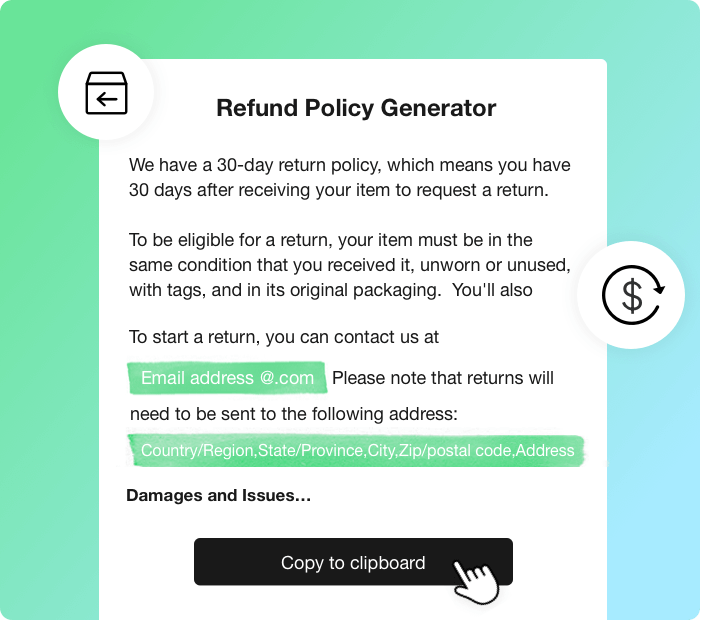Shopify Refund Policy Generator
A good refund or return policy can help protect your company and earn your customers' trust, but it's extremely important to make sure your language is clear and concise. Our return policy template can help you easily generate a professional, ready-to-use refund or return policy.
Enter your company&Policy information
Generated Refund Policy Template
How to generator your refund policy for shopify
-

Enter the information
Fill in all your real store information in the input box.
-

Generator refund policy
Click "generate" to view the policies generated on the right.
-

Copy the policy to your refund policy page
Copy the generated refund policy to your store refund policy page.
Best refund policy generator for shopify
The most suitable privacy policy generator for shopify websites.
-
Built for Shopify stores
-
E-commerce site
-
WooCommerce site
-
Dropshipping site
-
Squarespace site
-
Wix site
-
Magento site
-
Weebly site
-
-
Adaptable to Your Needs
-
Customize your return policy to fit your eCommerce store's requirements.
-
-
Easy to Use
-
Easy to operate
-
Flexible configuration
-
Fast generation
-
-
Industry-Standard Refund Policy Template
-
Use a refund policy generator to create an industry-standard refund&return policy for your eCommerce store.
-
-
Design it your way
-
Our privacy policy template is easy to read, plus more customizations coming soon!
-
-
Google Analytics
-
Add your Google Analytics pixel and other analytics platforms
-
These are the benefits of using the shopify Refund Policy Builder
Free generator your Return & Refund Policy

Download your Refund & Return policy

Other free tools
- Shopify Theme Detector
- Shopify App Detector
- Dropshipping Traffic Calculator
- Dropshipping Cpa Calculator
- TikTok Ad Cost Calculator
- Dropshipping Profit Calculator
- Dropshipping Profit Margin Calculator
- Shopify Privacy Policy Generator
- Shopify Returns Policy Generator
- Shopify Terms and Conditions Generator
- Shopify Shipping Policy Generator
Frequently Asked Questions
Yes, Shopify provides a default refund policy template that you can customize for your store. When you set up your Shopify store, you'll have the option to use the default template or create your own refund policy. The default template covers the basic information that a refund policy should include, such as the timeframe for returns and the condition of the product required for a refund. However, it's important to customize the policy to fit your specific business needs and to comply with local laws and regulations. You can access the refund policy template in your Shopify admin dashboard under "Settings" and "Legal".
When writing a refund policy for your Shopify store, you should include the following information:
- 1. Timeframe: The policy should specify how long customers have to request a refund or return a product for an exchange. This timeframe can vary depending on the type of products you sell, but it's important to be clear and consistent.
- 2. Condition: The policy should outline the condition the product must be in to be eligible for a refund or exchange. This can include whether the product needs to be unused, unopened, or in its original packaging.
- 3. Refund method: The policy should detail how the refund will be issued, such as a credit to the customer's account or a refund to the original payment method.
- 4. Exceptions: The policy should list any specific products or situations that are not eligible for a refund or exchange. This can include customized or personalized products, final sale items, or products that have been used or damaged by the customer.
- 5. Shipping and handling: The policy may include details on who is responsible for covering the cost of return shipping, as well as any handling fees that may apply.
- 6. Contact information: The policy should provide contact information for customers to reach out to with any questions or concerns about the refund process.
Here are the steps to write a refund policy on Shopify:
- 1. Log in to your Shopify admin dashboard and click on "Settings" in the bottom left corner.
- 2. Click on "Legal" in the drop-down menu.
- 3. Under "Refund policy," click "Create from template."
- 4. Choose a template that best fits your needs or select "I want to create my own refund policy."
- 5. Write a clear and concise statement that outlines your refund policy.
Here's how you can do it:
- 1. Go to your Shopify dashboard and click on "Settings" and then "Legal".
- 2. Under "Refund policy," click "Create from template."
- 3. Select "I want to create my own refund policy."
- 4. Write a clear and concise statement that explains your no refund policy. For example: "All sales are final. We do not offer refunds or exchanges for any reason."
- 5. Make sure to include any exceptions or special circumstances that may apply, such as damaged or defective products.
- 6. Once you've written your policy, click "Save" to publish it on your website.
Yes, as a Shopify merchant, it is important to have a refund policy in place and clearly displayed on your website. This is required by Shopify's Terms of Service, which state that all merchants must have a clearly outlined refund policy that is easily accessible to customers.
A standard refund policy typically outlines the terms and conditions under which a customer can return or exchange a product and receive a refund. The specific details of a refund policy can vary depending on the company or organization, but there are a few common elements that are typically included:
- 1. Timeframe: The policy will specify how long a customer has to return a product for a refund. This can range from a few days to several months, depending on the product and the company.
- 2. Condition: The policy will specify the condition the product must be in to be eligible for a refund. For example, the product may need to be unused, unopened, or in its original packaging.
- 3. Refund method: The policy will detail how the refund will be issued, such as a credit to the customer's account or a refund to the original payment method.
- 4. Exceptions: The policy will list any specific products or situations that are not eligible for a refund, such as customized or personalized products.
A good refund policy is one that is clear, fair, and easy to understand for customers. Here are some key elements that make up a good refund policy:
- 1. Clear and specific: Your refund policy should be clearly stated on your website or on the product packaging, and should provide specific details about what is eligible for a refund, how long customers have to request a refund, and any other important terms and conditions.
- 2. Fair: Your policy should be fair to both you and your customers. It should not be overly restrictive or unfair to customers, while still protecting your business from fraud and abuse.
- 3. Easy to understand: Your policy should be written in plain language that is easy for customers to understand. Avoid using legal jargon or technical terms that may confuse customers.
- 4. Consistent: Your policy should be consistent across all products and services you offer, and should be applied equally to all customers.
- 5. Customer-focused: Your policy should focus on providing a positive customer experience, even in the event of a refund. This may include offering an easy and hassle-free refund process, and providing prompt and courteous customer service.
Just visit this page, you will find the shopify refund policy template. You can copy and use the shopify refund policy template for your store.
https://www.pipiads.com/tools/shopify-privacy-policy-generator
Yes, it is okay for a business or individual to refuse a refund under certain circumstances.
If a customer is not entitled to a refund according to the business's refund policy, or if the item has been used or damaged, then the business can refuse to provide a refund. In some cases, a business may offer store credit or an exchange instead of a refund.
It's important to note that businesses must follow applicable laws and regulations related to refunds and returns. These laws may vary depending on the country and region, as well as the type of product or service being offered.
In general, it's a good practice for businesses to have a clear and well-communicated refund policy to avoid misunderstandings and disputes with customers.